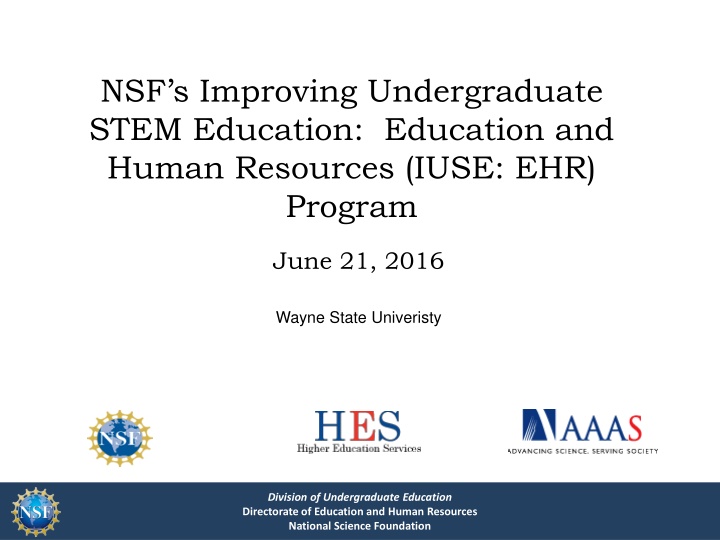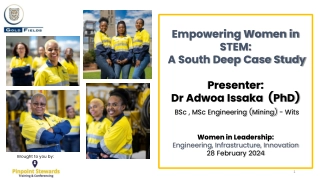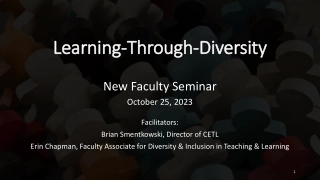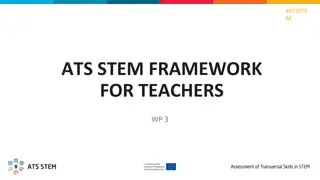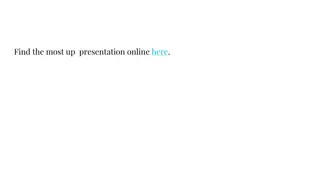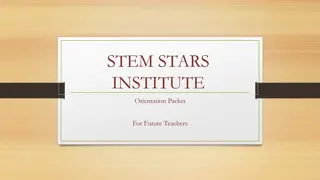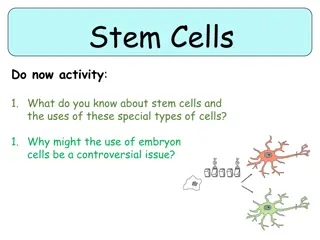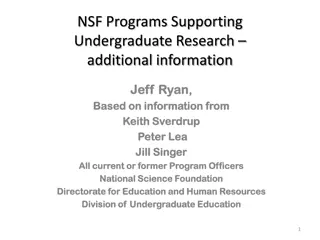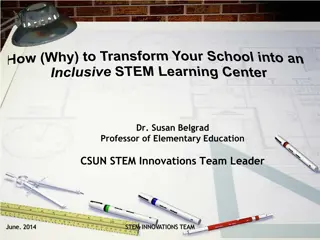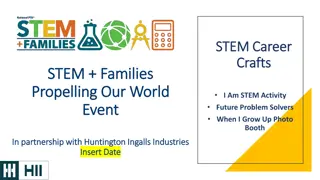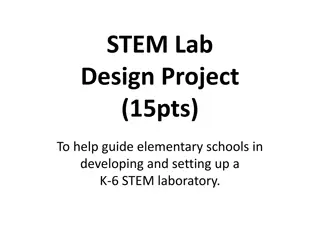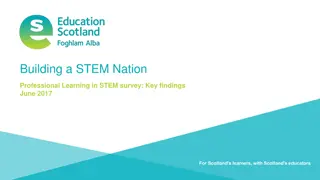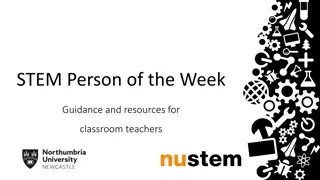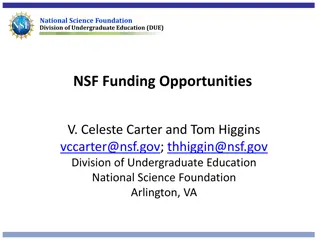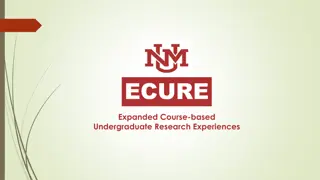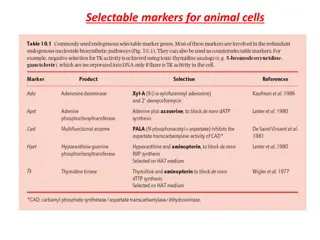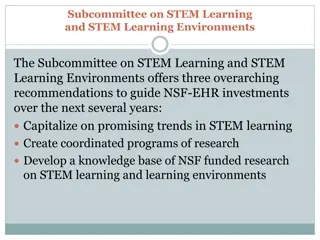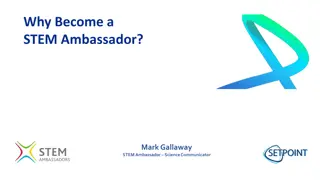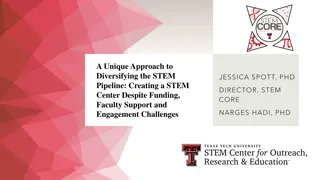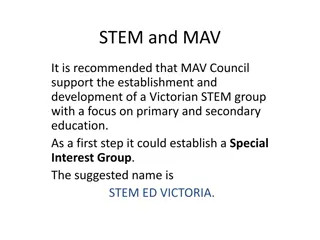Improving Undergraduate STEM Education Program Overview
The NSF's Improving Undergraduate STEM Education program presented by Wayne State University provides an in-depth look at the IUSE: EHR program, its vision, goals, and key elements. Topics covered include engaged student learning, community transformation, and program considerations.
Download Presentation

Please find below an Image/Link to download the presentation.
The content on the website is provided AS IS for your information and personal use only. It may not be sold, licensed, or shared on other websites without obtaining consent from the author.If you encounter any issues during the download, it is possible that the publisher has removed the file from their server.
You are allowed to download the files provided on this website for personal or commercial use, subject to the condition that they are used lawfully. All files are the property of their respective owners.
The content on the website is provided AS IS for your information and personal use only. It may not be sold, licensed, or shared on other websites without obtaining consent from the author.
E N D
Presentation Transcript
NSFs Improving Undergraduate STEM Education: Education and Human Resources (IUSE: EHR) Program June 21, 2016 Wayne State Univeristy Division of Undergraduate Education Directorate of Education and Human Resources National Science Foundation
Presenter Myles Boylan, mboylan@nsf.gov IUSE: EHR Program Director Division of Undergraduate Education Directorate of Education and Human Resources National Science Foundation
Topics Introduction to IUSE: EHR Program Program description Engaged Student Learning Track Institution and Community Transformation Track Q&A #1 Additional program details Important program considerations Workshops and conferences Review criteria (separately) Proposal preparation advice Q&A #2 Division of Undergraduate Education Directorate of Education and Human Resources National Science Foundation
IUSE: EHR Introduction IUSE: EHR is beginning its fourth year of operation IUSE: EHR is a broad program focused on undergraduate STEM education For all types of institutions of higher education For all aspects of undergraduate STEM education This includes Pre-service education for future K- 12 teachers of any STEM discipline Division of Undergraduate Education Directorate of Education and Human Resources National Science Foundation
IUSE: EHR Vision All undergraduate students fully engaged in their STEM learning Both majors and non-majors Institutions of higher education deeply committed to the broad use of research-based teaching approaches Division of Undergraduate Education Directorate of Education and Human Resources National Science Foundation
IUSE: EHR Vision (cont.) The IUSE: EHR program recognizes the key role faculty play both as Creators of innovative learning materials and teaching approaches, and Implementers of promising practices. Division of Undergraduate Education Directorate of Education and Human Resources National Science Foundation
IUSE: EHR Overarching Goals To promote: 1) The development, use, and testing of instructional practices and curricular innovations that engage and improve student learning and retention in STEM, and 2) Community and institutional transformation that will increase opportunities for the application of highly effective STEM teaching methods. Division of Undergraduate Education Directorate of Education and Human Resources National Science Foundation
IUSE: EHR Program Goals Improve STEM Learning & Learning Environments: Improve the knowledge base for effective teaching and learning Foster widespread use of evidence-based resources and pedagogies Broaden Participation & Institutional Capacity for STEM Learning: Increase the number and diversity of STEM majors by improving and using evidence-based strategies Build the Professional STEM Workforce for Tomorrow: Enable students to become productive members of the STEM work force and of our STEM-literate society Division of Undergraduate Education Directorate of Education and Human Resources National Science Foundation
IUSE: EHR Program Goals (cont.) Program goals include: developing increased use of inquiry-based laboratories and research-based courses; further work on effective STEM learning and teaching foundational research on STEM teaching and STEM learning. The program supports efforts that bring recent advances in science & engineering into undergraduate education and research provide all undergraduate students with STEM competencies. Division of Undergraduate Education Directorate of Education and Human Resources National Science Foundation
IUSE: EHR FY2016 program calls for proposals to: use and build evidence about improved STEM instructional practices; design and study innovative learning opportunities, including cyberlearning; create, implement, and test program, curricular, course, and technology-driven models; develop, implement, and test creative approaches for adoption of education research into disciplinary teachings; develop and validate assessments/metrics for undergraduate STEM learning and instructional practice; and conduct fundamental research on issues of undergraduate STEM teaching and learning. Division of Undergraduate Education Directorate of Education and Human Resources National Science Foundation
IUSE: EHR Program Tracks and Funding Tiers Engaged Student Learning Track Exploration and Design Tier (up to $300K, 3 years) Development and Implementation Tier Level l (up to $600K, 3 years) Development and Implementation Tier Level II ($601K-$2M, 5 years) Institutional and Community Transformation Track Exploration and Design Tier (up to $300K, 3 years) Development and Implementation Tier -- (up to $3M, 5 years) Research studies may be submitted to either Track Workshop and conference proposals are encouraged Division of Undergraduate Education Directorate of Education and Human Resources National Science Foundation
The first focal point Engaged Student Learning Track Division of Undergraduate Education Directorate of Education and Human Resources National Science Foundation
IUSE: EHR Engaged Student Learning Track Engaged Student Learning track projects Focus on design, development, and research studies Involve the creation, exploration, or implementation of tools, resources, and models that show promise to increase engagement in STEM learning lead to measurable and lasting learning gains Reflect disciplinary differences in needs and priorities Division of Undergraduate Education Directorate of Education and Human Resources National Science Foundation
Engaged Student Learning Track Collaborations are encouraged among STEM disciplinary researchers Education researchers Cognitive scientists Such collaborations should Leverage what is known about how people learn Contribute to the growth of that body of knowledge Division of Undergraduate Education Directorate of Education and Human Resources National Science Foundation
Engaged Student Learning Track: Expectations Projects are expected to be both knowledge-based and knowledge- generating Division of Undergraduate Education Directorate of Education and Human Resources National Science Foundation
Engaged Student Learning Track: Exploration and Design Projects Small-scale efforts Deadline of November 2, 2016 Budgets up to $300,000 (including indirect costs) Maximum duration of 3 years These projects may seek to Pose and investigate new interventions, teaching materials, or instructional strategies Pose and investigate new methods of assessing student learning and achievement Adapt and implement strategies that have proven effective at other institutions Many others consistent with IUSE: EHR Program goals Expected to contribute to the body of knowledge about STEM teaching and learning , and/or effective means to broader implementation Division of Undergraduate Education Directorate of Education and Human Resources National Science Foundation
Engaged Student Learning Track: Design & Development Level I Larger projects Deadline of January 11, 2017 Budget up to $600,000 (including indirect costs) Maximum duration of 3 years Focus on achieving Greater refinement of working prototypes and approaches Testing and propagation beyond a single institution or Impacts across multiple STEM disciplines within an institution Evaluation should produce quality evidence on the effectiveness of the project used in multiple settings Division of Undergraduate Education Directorate of Education and Human Resources National Science Foundation
Engaged Student Learning Track: Design & Development Level II Largest scale projects Deadline of January 11, 2017 Budget between $601,000 and $2,000,000 Maximum duration of 5 years Intended to support Initiatives that have been found to be effective at smaller scales Large-scale efforts Long-term research on impacts As with Level I grants, evaluation should produce quality evidence on the effectiveness of the project used in multiple settings Division of Undergraduate Education Directorate of Education and Human Resources National Science Foundation
The second focal point Institutional and Community Transformation (ICT) Track Division of Undergraduate Education Directorate of Education and Human Resources National Science Foundation
Institutional & Community Transformation Track Competitive Institutional and Community Transformation projects will include a description of the theory of change that is guiding the proposed work. Competitive proposals should be informed by the research literature and theoretical perspectives concerning organizational change Promising proposals recognize that STEM higher education is a complex system, and that achieving change goals involves analyzing and addressing the relevance and impact of critical organizational factors that could impede or facilitate progress toward the stated goals. Division of Undergraduate Education Directorate of Education and Human Resources National Science Foundation
Institutional & Community Transformation Track Projects that intend to promote institutional change will typically require Teams of faculty members Support from the department chairs, college deans, or others within the institution's academic leadership Support from Provosts or Presidents for large projects is recommended Student sensitivities Division of Undergraduate Education Directorate of Education and Human Resources National Science Foundation
Institutional & Community Transformation Track: Focus Institutional and Community Transformation projects may Focus on increase the propagation of highly effective teaching and learning methods, curricular and co-curricular practices across/within disciplinary communities Be proposed by an institution or set of institutions Be proposed by professional communities Seek to transform high enrollment, lower division courses Implement their efforts in multiple courses within a department or a college or in a particular disciplinary area Focus on faculty learning through professional development Use technology and distance education (or hybrid) models Focus on leadership development for pedagogical and curricular innovation Division of Undergraduate Education Directorate of Education and Human Resources National Science Foundation
Institutional & Community Transformation Track: Expectations Projects are expected to be both knowledge-based and knowledge-generating Division of Undergraduate Education Directorate of Education and Human Resources National Science Foundation
Institutional & Community Transformation Track Exploration & Design Projects Small-scale efforts Deadline of November 2, 2016 Budgets up to $300,000 (including indirect costs) Maximum durations of 3 years These projects may seek to Develop strategies for the adoption, adaptation, and implementation of effective practices by a growing number of faculty instructors Explore challenges to their adoption, with the goal of informing policy, practice, and future development in education enterprise Expected to contribute to the body of knowledge about STEM teaching and learning and/or effective means of broader implementation Division of Undergraduate Education Directorate of Education and Human Resources National Science Foundation
Institutional & Community Transformation Track: Development and Implementation Projects Large scale projects Deadline January11, 2017 Budget limit of $3,000,000 (including indirect costs) Maximum duration of 5 years Typically focus on ambitious efforts to achieve the widespread deployment of effective instructional, curricular, and co-curricular practices in support of student engagement, learning, and retention. Evaluation should produce high quality evidence about the effectiveness of the project. In effect these large projects are applied research projects investigating the effectiveness of models of change. Division of Undergraduate Education Directorate of Education and Human Resources National Science Foundation
Q&A -1 Division of Undergraduate Education Directorate of Education and Human Resources National Science Foundation
Here are some tips for succeeding Important Considerations Some Emphasis Areas in the IUSE: EHR Solicitation Division of Undergraduate Education Directorate of Education and Human Resources National Science Foundation
Knowledge-Based and Knowledge- Generating Successful projects can act locally but also think nationally Seek to produce valuable changes locally Seek to generate knowledge that would be useful to other STEM faculty in other institutions Knowledge producing aspect is more than project evaluation It is research that is contextualized within teaching practices, institutional goals, and student impacts The Monograph on Common Guidelines for Education R&D (August, 2013) may be helpful in designing the evaluation/ knowledge producing part of a good proposal Division of Undergraduate Education Directorate of Education and Human Resources National Science Foundation
Interaction Between STEM Education Research and Practice Collaborations among STEM disciplinary experts and STEM education researchers fosters a cycle of innovation New questions emerge from innovative practice to be solved by new research New solutions derived from research to be implemented through modified practice Collaboration among STEM disciplinary experts, STEM education researchers or cognitive scientists, and STEM education practitioners are encouraged Division of Undergraduate Education Directorate of Education and Human Resources National Science Foundation
Transportability and Propagation Expectation Transferability and propagation are important considerations for IUSE: EHR-supported efforts They should be addressed throughout a project's lifetime Approaches should be designed for use in a large variety of institutions Principal Investigators are encouraged to consider The value of the project from the perspective of other users The relationships, partners, and structures which would eventually be needed to sustain the improvement on a wide scale Division of Undergraduate Education Directorate of Education and Human Resources National Science Foundation
A special category of proposal Research Project Proposals Division of Undergraduate Education Directorate of Education and Human Resources National Science Foundation
Research Projects Projects that are predominantly research studies may be submitted to either IUSE: EHR Track Research may explore Enhancement of student learning and attitudes through teaching strategies and effective curricula Diffusion of widespread practices through the community Effective professional development Effective institutional change models These are examples, many other themes are appropriate. Please contact an NSF program officer if you have questions about whether or not your project is appropriate Division of Undergraduate Education Directorate of Education and Human Resources National Science Foundation
Workshops and Conferences Proposals for workshops and conferences addressing critical challenges in undergraduate STEM education may be submitted at any time Typically these include budgets up to $50,000 or between $50,000 and $100,000 You must consult with an NSF Program Officer before submission to determine whether the proposed workshop or conference is considered appropriate for IUSE: EHR. Division of Undergraduate Education Directorate of Education and Human Resources National Science Foundation
Some Insights from former POs General Advice Division of Undergraduate Education Directorate of Education and Human Resources National Science Foundation
Knowledge-Based Expectation As you would do for a research proposal Provide an evidence-based justification of the importance of the proposed topic Provide an evidence-based justification of the selected approach These should be substantial discussions with references to the literature Do this for proposals for both Engaging Student Learning Track Institution and Community Transformation Track Division of Undergraduate Education Directorate of Education and Human Resources National Science Foundation
Knowledge-Generating Expectation Describe plans for collecting, analyzing, and sharing data Make evaluation an integral part of the project Include specific and measurable goals and objectives Identify your evaluator at the time of submission Include an evaluation plan to determine the effect of the intervention All proposals should have distinct evaluation and research questions. Research and evaluation may have overlapping data sources Do this for proposals in both Engaging Student Learning Track Institution and Community Transformation Track Division of Undergraduate Education Directorate of Education and Human Resources National Science Foundation
Transportability and Propagation Expectation Propagation - the process and activities that a project uses to get others to adopt and adapt its products and results Dissemination is an essential part of propagation Transportability the characteristics and features of a project s products and results that facilitate their adoption by others and their adaptation to new contexts Division of Undergraduate Education Directorate of Education and Human Resources National Science Foundation
Transportability and Propagation Expectation Describe your plans for making your project transportable and/or portable. When possible, describe your plans for encouraging, enabling, and facilitating your projects transportable products by others. Provide an knowledge-based justification for your approaches Evaluate your projects efforts with respect to transportability and propagation. Do this for proposals in both Engaging Student Learning Track Institution and Community Transformation Division of Undergraduate Education Directorate of Education and Human Resources National Science Foundation
Q&A 2 Division of Undergraduate Education Directorate of Education and Human Resources National Science Foundation
IUSE: EHR Website For more information on IUSE: EHR Program visit http://www.nsf.gov/pubs/2015/nsf15585/nsf15585.htm Google NSF IUSE Division of Undergraduate Education Directorate of Education and Human Resources National Science Foundation
IUSE Resources Grant Proposal Guide (GPG) http://www.nsf.gov/publications/pub_summ.jsp ?ods_key=gpg Common Guidelines for Education R&D http://www.nsf.gov/pubs/2013/nsf13126/nsf131 26.pdf Division of Undergraduate Education Directorate of Education and Human Resources National Science Foundation
